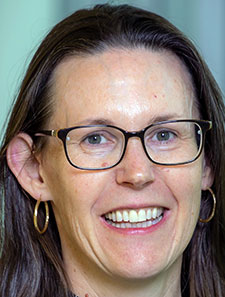 Being the newest anything can be both a blessing and a curse. For SHM’s Research Special Interest Group, which just formed in October 2024, the positives of being so new are that the group is unburdened by any legacy issues and that it’s free to create its own path however it likes. The negatives, for those who’d choose to see them, are that they have no structure, no clear path forward, and no history to rely on.
Being the newest anything can be both a blessing and a curse. For SHM’s Research Special Interest Group, which just formed in October 2024, the positives of being so new are that the group is unburdened by any legacy issues and that it’s free to create its own path however it likes. The negatives, for those who’d choose to see them, are that they have no structure, no clear path forward, and no history to rely on.
As for SIG Chair Angela Keniston, PhD, MSPH, she sees only the upside.
“It feels like a blessing,” she said. “I am actually going to be actively recruiting a vice chair and a secretary because right now it’s just me. I have a bunch of colleagues on SHM’s Research Committee who have stepped up to help me really get this going. But, you know, they will ideally step back and make space for some others within SHM who would be interested.”
For Dr. Keniston, director of data and analytics in the division of hospital medicine at the University of Colorado Department of Medicine, the SIG is just another outreach effort to widen what people think the definition of research is.

Dr. Keniston
“I define research pretty broadly,” said Dr. Keniston, who’s been involved in research efforts in hospital medicine and other specialties for some 25 years. “In my experience in hospital medicine, research lives in this grey space where operations, quality improvement, and research cross over. I’m hoping we attract people who aren’t just working in more traditional research settings, but people who are doing really exciting, innovative quality improvement or medical education work. “
Dr. Keniston, who is also an assistant professor, sat on SHM’s Research Committee for years, but sees a SIG as being able to get more people involved, particularly as the committee has only so many slots and requires an approval process. The SIG requires only the effort to sign up.
“SIGs are an amazing opportunity to just invite people in regardless of their level of experience with research,” she said. “If they are an MD, an APP, a PhD, a Master of Science, whatever their training background might be, whatever their interest or experience with research might be, to invite them in and give them a home where they can meet other people engaged in research, interested in research.
“A home where they can build collaborations and relationships, and we can work on some things that are maybe a little more innovative, a little quirky compared to what the research committee does.”
That’s not to say that the nascent SIG won’t look to partner with the committee to align efforts. In addition, Dr. Keniston is also focused on the idea of working with other SIGs, as research initiatives often exist at the intersection of other subject matter areas that have long had dedicated SIGs. But the Research SIG’s overarching goal is to get more people working on more projects and talking to each other more.
“What do people who have an interest in research want to work on?” Dr. Keniston said. “How can we build from this really diverse community of people to come up with projects and initiatives that will, yes, align with SHM’s strategic goals, but will be outside the scope of the Research Committee?
“And then the other thing is, that we really want to build is some visibility for research across SHM and identify people who maybe haven’t even really thought of themselves as researchers, but when you look at the work that they do, the non-clinical work, through a different lens, they’re like, ‘Oh, yeah, I am a researcher. And there is a community for me’.”
Efforts have started quickly. The SIG already held its first event, with the SIG taking over the National Hospital Medicine Writing Challenge from the Research Committee. There is a virtual launch event in April and Dr. Keniston is hopeful that it will build more momentum before SHM Converge in Las Vegas.
Dr. Keniston may be a career researcher, but she’s also putting on her marketing hat for the SIG. She’s been actively promoting the new group via SHM’s HMX, as well as posting about it on social media sites including BlueSky, Threads, and LinkedIn. She’s also using personal and professional networks to get outside the traditional research forums. The message is always the same.
“I just really would love for people to consider joining and being a part of this diverse community,” she said. “We’re trying to build some greater inclusivity, greater collaboration, a space of innovation for people. You don’t have to be a traditional researcher. You can have just a little bit of interest. You could have done one project that was kind of sort of research in your whole career, and this is a space for you.”
Richard Quinn is a freelance writer in New Jersey.